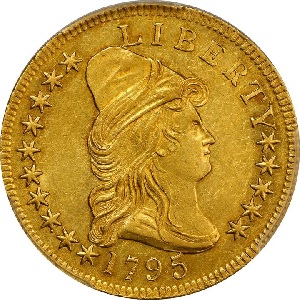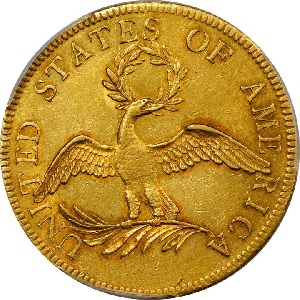1795 Capped Bust Small Eagle $10 Eagle, 13 Leaves
The $10 U.S. gold eagle was the largest face value authorized by the 1792 Mint Act. It was intended to be America’s ambassador to the world and was given the name “eagle” after the national bird symbolizing the new republic on the west side of the Atlantic.(1)
The first of the U.S. gold eagles was presented by Mint Director Henry W. de Saussure to President Washington in October 1795. A few weeks prior to the meeting with the president, the $5 half eagle of the same design was issued.
Chief Engraver Robert Scot featured Miss Liberty wearing a turban cap of a style popular with women of that era. She faces right, the word LIBERTY above her at 2 o’clock and the date directly below her. The reverse shows an eagle with wings outstretched, holding a wreath aloft in its beak. The eagle sits on a palm branch, almost fully surrounded by the inscription UNITED STATES OF AMERICA.
These early ten dollar gold pieces are called Capped Bust eagles. Many numismatists also refer to them as Turban Head Eagles, after the cap style worn by Miss Liberty.
The accepted mintage figure for the 1795 is 5,583 pieces. There are two major varieties, one with 13 leaves on the branch below the eagle and one with 9 leaves. The 9 leaves variety was not recognized until the last few decades.(2)
There are five die varieties known to produce the 1795 eagle having 13 leaves. Those struck with the BD-1 variety are most frequently seen.(3)
Production of the $10 eagle was suspended after 1804. Because the value ratio of gold to silver on the world stage moved, exportation of United States gold coins became a profitable enterprise, prompting the end of eagle coinage.(4) It was not until 1838 that new $10 eagles were struck again.
The 1795 eagle was the first of the largest gold coin struck under the authority of the 1792 Mint Act. Some scholars argue it is the most historically important United States gold coin ever issued, explaining why it has long been a favorite of advanced numismatists.(5)
| Estimated survivors in all grades: 500 ?
The survivor estimate from PCGS represents an average of one or more experts' opinions as to how many examples survive of a particular coin in all grades. Survival estimates include coins that are raw, certified by PCGS, and certified by other grading services. Learn more at PCGS. |
| PCGS Rarity Scale: 6.0 ?
The 'PCGS CoinFacts Rarity Scale' assesses the relative rarity of all U.S. coins, based on estimated surviving examples. The scale runs from 1.0 to 10.0. The higher the number, the rarer the coin.
Learn more at PCGS. |
| Click HERE to check for availability on eBay** |
Preview of eBay selection (early rare U.S. gold seldom appears for sale, but keep checking):
 |
 |
| Trendline Avg = 15.87 | GOOD |
Historic Value Trend Charts:
| Last updated 9-6-24 | Return to Key Date Coin List | |
| There are no Common Date comparisons for this coin. | ||
|
|
||
| Download Charts to Your Computer | ||
Sources
1. Doty, Richard. America's Money, America's Story. Iola, WI: Krause Publications, 1998.
2. Garrett, Jeff and Guth, Ron. 100 Greatest U.S. Coins, 5th ed. Pelham, AL: Whitman Publishing, 2019.
3. PCGS. 1795 $10 13 Leaves (Regular Strike).
4. Heritage Auctions. 1795 $10 13 Leaves.
5. Heritage Auctions. 1795 $10 13 Leaves.
**Many very fine coin dealers sell on eBay. At any point in time, there may be over one million search results for United States coins. This includes quite a few of the recommendations on our Key Date Coin List.
If you’re thinking about purchasing a rare coin, eBay is certainly worth a look. For your convenience, the links from this site to eBay are coded to bring up only coins certified by PCGS and NGC.
As is always, always the case, never buy a valuable coin from a seller whose trustworthiness cannot be verified. Learn more about this at our chapter Best Places to Buy Coins, which also has a section on doing business on eBay.
In the interest of full disclosure, Rare Coins 101 receives a small commission anytime someone connects to eBay from this site and purchases something.
Coin images by Stack's Bowers Galleries.


